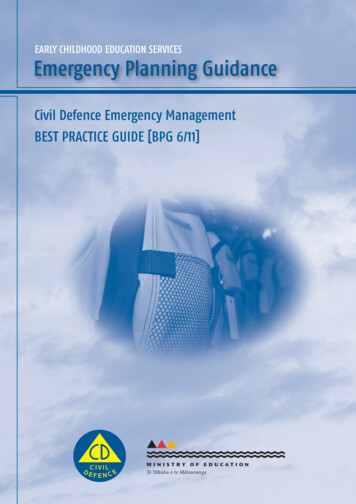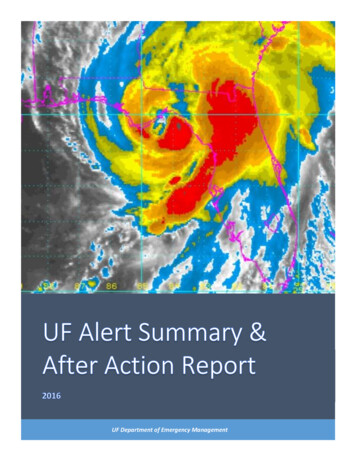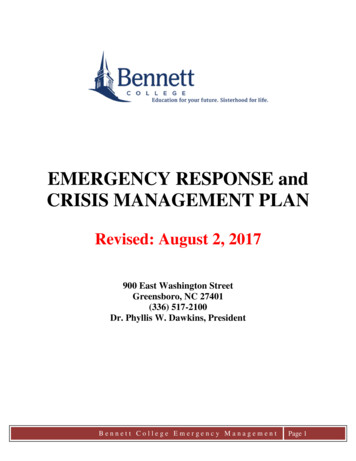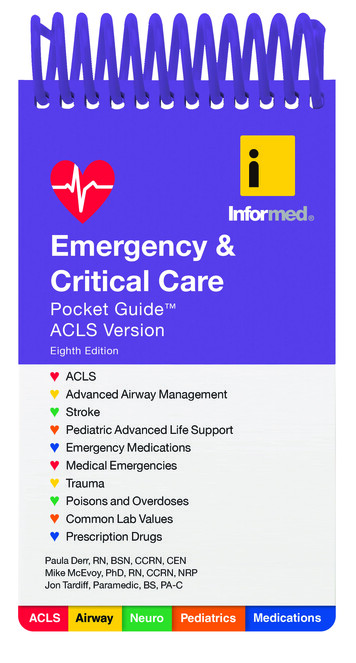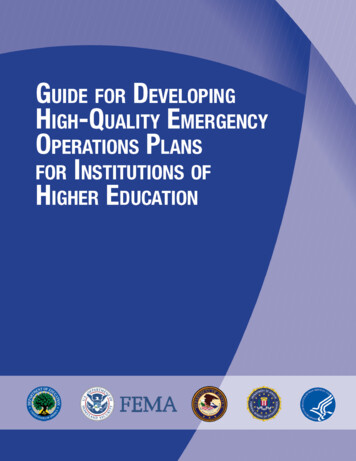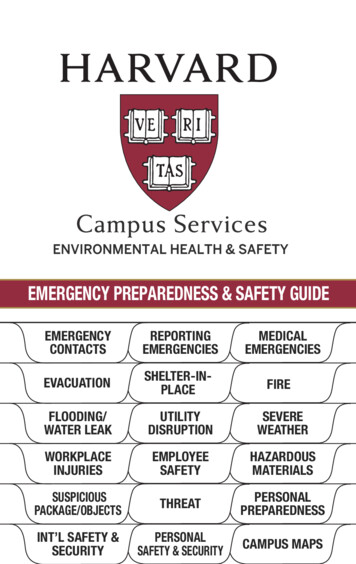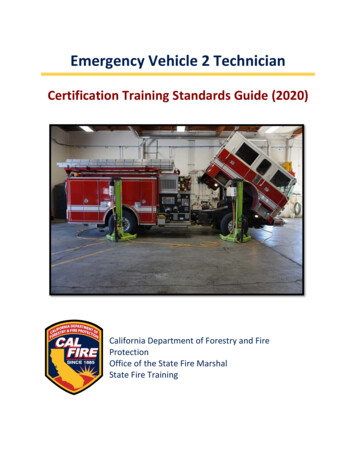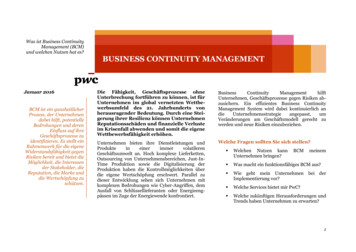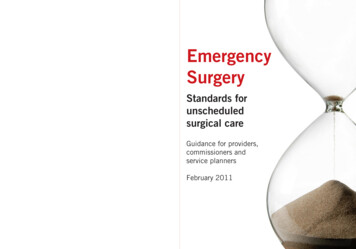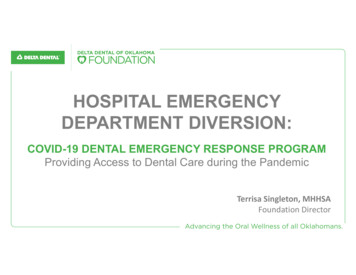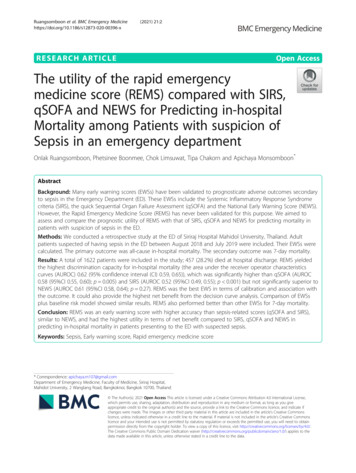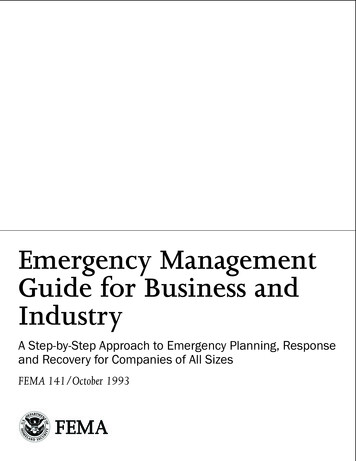
Transcription
Emergency ManagementGuide for Business andIndustryA Step-by-Step Approach to Emergency Planning, Responseand Recovery for Companies of All SizesFEMA 141/October 1993
EMERGENCY MANAGEMENT GUIDE FORBUSINESS & INDUSTRYA STEP-BY-STEP APPROACH TO EMERGENCY PLANNING,RESPONSE AND RECOVERY FOR COMPANIES OF ALL SIZESSponsored by a Public-Private Partnership with the Federal Emergency Management AgencySpecial thanks to the following organizations for supporting the development, promotion anddistribution of the Emergency Management Guide for Business & Industry:American Red CrossAmerican Insurance AssociationBuilding Owners and Managers Association InternationalChemical Manufacturers AssociationFertilizer InstituteNational Association of ManufacturersNational Commercial Builders Councilof the National Association of Home BuildersNational Coordinating Council on Emergency ManagementNational Emergency Management AssociationNational Industrial Council — State Associations GroupNew Jersey Business & Industry AssociationPacific BellPennsylvania Emergency Management Agency
The Emergency Management Guide for Business & Industry was produced by the Federal Emergency Management Agency(FEMA) and supported by a number of private companies and associations representing business and industry.The approaches described in this guide are recommendations, not regulations. There are no reporting requirements, nor willfollowing these principles ensure compliance with any Federal, State or local codes or regulations that may apply to yourfacility.FEMA is not a regulatory agency. Specific regulatory issues should be addressed with the appropriate agencies such as theOccupational Safety and Health Administration (OSHA) and the Environmental Protection Agency (EPA).Prepared under FEMA Contract EMW-90-C-3348 by:Thomas WahleOgilvy Adams & RinehartWashington, D.C.(202) 452-9419Gregg BeattyRoy F. Weston, Inc.Rockville, Maryland(301) 646-6855
TABLEOFCONTENTSINTRODUCTIONAbout This Guide .5What Is an Emergency? .5What Is Emergency Management?.6Making the “Case” for Emergency Management.6SECTION 1: 4 STEPS IN THE PLANNING PROCESSSTEP 1 - ESTABLISH A PLANNING TEAMForm the Team .9Establish Authority .10Issue a Mission Statement .10Establish a Schedule and Budget.10STEP 2 - ANALYZE CAPABILITIES AND HAZARDSWhere Do You Stand Right Now? .11Review Internal Plans and Policies.11Meet with Outside Groups.11Identify Codes and Regulations .12Identify Critical Products, Services and Operations.12Identify Internal Resources and Capabilities .12Identify External Resources.13Do an Insurance Review .13Conduct a Vulnerability Analysis .14List Potential Emergencies.14Estimate Probability .15Assess the Potential Human Impact.15Assess the Potential Property Impact .15Assess the Potential Business Impact .16Assess Internal and External Resources.16Add the Columns.16
STEP 3 - DEVELOP THE PLANPlan Components .17Executive Summary .17Emergency Management Elements.17Emergency Response Procedures .18Support Documents .18The Development Process .19Identify Challenges and Prioritize Activities .19Write the Plan .19Establish a Training Schedule.19Continue to Coordinate with Outside Organizations .19Maintain Contact with other Corporate Offices.20Review, Conduct Training and Revise .20Seek Final Approval .20Distribute the Plan.20STEP 4 - IMPLEMENT THE PLANIntegrate the Plan into Company Operations.21Conduct Training.22Planning Considerations.22Training Activities .22Employee Training .23Evaluate and Modify the Plan .24SECTION 2: EMERGENCY MANAGEMENT CONSIDERATIONSDirection and Control .27Emergency Management Group (EMG) .27Incident Command System (ICS).28Emergency Operations Center (EOC) .28Planning Considerations.29Security .29Coordination of Outside Response .29
Communications.31Contingency Planning .31Emergency Communications .31Family Communications.32Notification.32Warning.32Life Safety.33Evacuation Planning .33Evacuation Routes and Exits.33Assembly Areas and Accountability.34Shelter .34Training and Information.34Family Preparedness .34Property Protection .35Planning Considerations .35Protection Systems .35Mitigation.35Facility Shutdown.36Records Preservation .37Community Outreach .39Involving the Community.39Mutual Aid Agreements.39Community Service.40Public Information .40Media Relations.41Recovery and Restoration .43Planning Considerations .43Continuity of Management.43Insurance .44Employee Support.44Resuming Operations .45Administration and Logistics .47Administrative Actions.47Logistics .47
SECTION 3: HAZARD-SPECIFIC INFORMATIONFire .51Hazardous Materials Incidents.53Floods and Flash floods.55Hurricanes .57Tornadoes.59Severe Winter Storms .61Earthquakes .63Technological Emergencies.65SECTION 4: INFORMATION SOURCESAdditional Readings from FEMA.69Ready-to-Print Brochures.71Emergency Management Offices .73APPENDIXVulnerability Analysis ChartTraining Drills and Exercises Chart
INTRODUCTION. A hurricane blasts through South Florida causingINTRODUCTIONmore than 25 billion in damages.A fire at a food processing plant results in 25 deaths, a company out ofbusiness and a small town devastated.A bombing in the World Trade Center results in six deaths, hundreds of injuriesand the evacuation of 40,000 people.A blizzard shuts down much of the East Coast for days. More than 150 lives arelost and millions of dollars in damages incurred.Every year emergencies taketheir toll on business and industry— in lives and dollars. But something can be done. Business andindustry can limit injuries anddamages and return more quicklyto normal operations if they planahead.About This GuideThis guide provides step-bystep advice on how to create andmaintain a comprehensive emergency management program. Itcan be used by manufacturers, corporate offices, retailers, utilities orany organization where a sizablenumber of people work or gather.Whether you operate from ahigh-rise building or an industrialcomplex; whether you own, rentor lease your property; whetheryou are a large or small company;the concepts in this guide willapply.To begin, you need not havein-depth knowledge of emergencymanagement. What you need isthe authority to create a plan anda commitment from the chiefexecutive officer to make emergency management part of yourcorporate culture.If you already have a plan, usethis guide as a resource to assessand update your plan.The guide is organized as follows:Section 1: 4 Steps in thePlanning Process — how to form aplanning team; how to conduct avulnerability analysis; how todevelop a plan; and how to implement the plan. The informationcan be applied to virtually any typeof business or industry.Section 2: Emergency ManagementConsiderations — how to buildsuch emergency managementcapabilities as life safety, propertyprotection, communications andcommunity outreach.Section 3: Hazard-SpecificInformation — technical information about specific hazards yourfacility may face.Section 4: Information Sources— where to turn for additionalinformation.What Is an Emergency?An emergency is any unplanned event that can causedeaths or significant injuries toemployees, customers or thepublic; or that can shut down yourbusiness, disrupt operations, causephysical or environmentaldamage, or threaten the facility’sfinancial standing or public image.PAGE 5
Obviously, numerous events canbe “emergencies,” including: Fire Hazardous materials incident Flood or flash flood Hurricane Tornado Winter storm Earthquake Communications failure Radiological accident Civil disturbance Loss of key supplier or customer ExplosionThe term “disaster” has beenleft out of this document becauseit lends itself to a preconceivednotion of a large-scale event, usually a “natural disaster.” In fact,each event must be addressedwithin the context of the impact ithas on the company and the community. What might constitute anuisance to a large industrial facility could be a “disaster” to a smallbusiness.What Is EmergencyManagement?Emergency management is theprocess of preparing for, mitigating, responding to and recoveringfrom an emergency.Emergency management is adynamic process. Planning,though critical, is not the onlycomponent. Training, conductingdrills, testing equipment and coordinating activities with the community are other important functions.PAGE 6Making the “Case”for EmergencyManagementTo be successful, emergencymanagement requires uppermanagement support. The chiefexecutive sets the tone by authorizing planning to take place anddirecting senior management toget involved.When presenting the “case” foremergency management, avoiddwelling on the negative effectsof an emergency (e.g., deaths,fines, criminal prosecution) andemphasize the positive aspects ofpreparedness. For example: It helps companies fulfill theirmoral responsibility to protectemployees, the community andthe environment. It facilitates compliance withregulatory requirements ofFederal, State and local agencies. It enhances a company’s abilityto recover from financial losses,regulatory fines, loss of marketshare, damages to equipmentor products or business interruption. It reduces exposure to civil orcriminal liability in the event ofan incident. It enhances a company’s imageand credibility with employees,customers, suppliers and thecommunity. It may reduce your insurancepremiums.
SECTION14 STEPS IN THE PLANNING PROCESSSTEP 1Establish a Planning TeamSTEP 2Analyze Capabilities and HazardsSTEP 3Develop the PlanSTEP 4Implement the Plan
ESTABLISH A PLANNING TEAM. There must be an individualSTEP 1or group in charge of developing the emergency management plan. The follow-ESTABLISHing is guidance for making the appointment.A PLANNINGTEAMForm the Team Public information officerThe size of the planning teamwill depend on the facility’s operations, requirements and resources.Usually involving a group ofpeople is best because: Security It encourages participation andgets more people invested inthe process. Finance and purchasing It increases the amount of timeand energy participants are ableto give.Their job descriptions couldalso reflect this assignment. Community relations Sales and marketing LegalHave participants appointed inwriting by upper management.Here’s one example of a planning team.COMMUNITY It provides for a broad perspective on the issues.Emergency ManagerFire & PoliceOther Response Organizations Line management Labor Human Resources Public RelationsPublic Information OfficerMANAGEMENT & PERSONNEL Safety & HealthMedicalSecurityEnvironmental AffairsLine ManagementLabor RepresentativeHuman Resources EMERGENCY RESPONSE SAFETY OFFICER/PLANNING TEAM Upper managementCOMMUNICATIONS Determine who can be anactive member and who can servein an advisory capacity. In mostcases, one or two people will bedoing the bulk of the work. Atthe very least, you should obtaininput from all functional areas.Remember: It enhances the visibility andstature of the planning process.SUPPORT eMaintenanceComputerData Maintenance Engineering and maintenance Safety, health and environmental affairsPAGE 9
Establish AuthorityDemonstrate management’scommitment and promote anatmosphere of cooperation by“authorizing” the planning groupto take the steps necessary todevelop a plan. The group shouldbe led by the chief executive orthe plant manager.Establish a clear line of authority between group members andthe group leader, though not sorigid as to prevent the free flow ofideas.Issue a MissionStatementHave the chief executive orplant manager issue a missionstatement to demonstrate thecompany’s commitment to emergency management. The statement should: Define the purpose of the planand indicate that it will involvethe entire organization Define the authority and structure of the planning groupPAGE 10Establish a Scheduleand BudgetEstablish a work schedule andplanning deadlines. Timelinescan be modified as prioritiesbecome more clearly defined.Develop an initial budget forsuch things as research, printing,seminars, consulting services andother expenses that may be necessary during the developmentprocess.
ANALYZE CAPABILITIES AND HAZARDS. This stepentails gathering information about current capabilities and about possiblehazards and emergencies, and then conducting a vulnerability analysis toSTEP 2ANALYZECAPABILITIESdetermine the facility’s capabilities for handling emergencies.AND HAZARDSWHERE DO YOU STAND RIGHT NOW?Review Internal Plansand PoliciesDocuments to look for include: Evacuation plan Fire protection plan Safety and health program Environmental policies Security procedures Insurance programs Finance and purchasingprocedures Plant closing policyMeet with OutsideGroupsMeet with government agencies, community organizations andutilities. Ask about potentialemergencies and about plans andavailable resources for respondingto them. Sources of informationinclude: Community emergencymanagement office Mayor or CommunityAdministrator’s office Employee manuals Local Emergency PlanningCommittee (LEPC) Hazardous materials plan Fire Department Process safety assessment Police Department Risk management plan Capital improvement program Emergency Medical Servicesorganizations Mutual aid agreements American Red CrossWhile researching potential emergencies, one facility discovered thata dam — 50 miles away — posed athreat to its community. The facility was able to plan accordingly. National Weather Service Public Works Department Planning Commission Telephone companies Electric utilities Neighboring businessesPAGE 11
Identify Codes andRegulationsIdentify applicable Federal,State and local regulations suchas: Occupational safety and healthregulations Environmental regulations Fire codes Seismic safety codesOne way to increase responsecapabilities is to identify employeeskills (medical, engineering,communications, foreign language) that might be needed in anemergency. Transportation regulations Zoning regulations Corporate policiesIdentify CriticalProducts, Servicesand OperationsYou’ll need this information toassess the impact of potentialemergencies and to determine theneed for backup systems. Areas toreview include: Company products and servicesand the facilities and equipment needed to produce them Products and services providedby suppliers, especially solesource vendors Lifeline services such as electrical power, water, sewer, gas,telecommunications and transportation Operations, equipment andpersonnel vital to the continued functioning of the facilityPAGE 12Identify InternalResources andCapabilitiesResources and capabilities thatcould be needed in an emergencyinclude: Personnel — fire brigade, hazardous materials response team,emergency medical services,security, emergency management group, evacuation team,public information officer Equipment — fire protectionand suppression equipment,communications equipment,first aid supplies, emergencysupplies, warning systems,emergency power equipment,decontamination equipment Facilities — emergency operating center, media briefing area,shelter areas, first-aid stations,sanitation facilities Organizational capabilities —training, evacuation plan,employee support system Backup systems — arrangements with other facilities toprovide for: Payroll Communications Production Customer services Shipping and receiving Information systems support Emergency power Recovery support
Identify ExternalResourcesDo an InsuranceReviewThere are many externalresources that could be needed inan emergency. In some cases, formal agreements may be necessaryto define the facility’s relationshipwith the following:Meet with insurance carriers toreview all policies. (See Section 2:Recovery and Restoration.) Local emergency managementoffice Fire Department Hazardous materials responseorganization Emergency medical services Hospitals Local and State police Community service organizations Utilities Contractors Suppliers of emergencyequipment Insurance carriersPAGE 13
CONDUCT A VULNERABILITY ANALYSISThe next step is to assess thevulnerability of your facility —the probability and potentialimpact of each emergency. Usethe Vulnerability Analysis Chartin the appendix section to guidethe process, which entails assigning probabilities, estimatingimpact and assessing resources,using a numerical system. Thelower the score the better. Geographic — What can happen as a result of the facility’slocation? Keep in mind:List PotentialEmergencies Technological — What couldresult from a process or systemfailure? Possibilities include: Fire, explosion, hazardousmaterials incident Safety system failure Telecommunications failure Computer system failure Power failure Heating/cooling systemfailure Emergency notificationsystem failureIn the first column of the chart,list all emergencies that couldaffect your facility, including thoseidentified by your local emergencymanagement office. Considerboth: Emergencies that could occurwithin your facility Emergencies that could occurin your communityBelow are some other factors toconsider. Historical — What types ofemergencies have occurred inthe community, at this facilityand at other facilities in thearea? Fires Severe weather Hazardous material spills Transportation accidents Earthquakes Hurricanes Tornadoes Terrorism Utility outagesPAGE 14Proximity to flood plains,seismic faults and dams Proximity to companies thatproduce, store, use or transport hazardous materials Proximity to major transportation routes and airports Proximity to nuclear powerplants Human Error — What emergencies can be caused byemployee error? Are employeestrained to work safely? D
This guide provides step-by-step advice on how to create and maintain a comprehensive emer-gency management program. It can be used by manufacturers, cor-porate offices, retailers, utilities or any organization where a sizable number of people work or gather. Whether you operate from a hig
